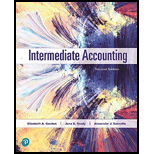
Intermediate Accounting (2nd Edition)
2nd Edition
ISBN: 9780134730370
Author: Elizabeth A. Gordon, Jana S. Raedy, Alexander J. Sannella
Publisher: PEARSON
expand_more
expand_more
format_list_bulleted
Concept explainers
Textbook Question
Chapter 9, Problem 9.7BE
Allowance for Uncollectible Accounts, Write-Off. Grotto Products, Inc. reported an opening balance in the allowance for doubtful accounts of $560,000. During the year, the company determined that a $23,000 receivable due from Zeer Company was uncollectible. Prepare the
Expert Solution & Answer
Want to see the full answer?
Check out a sample textbook solution
Students have asked these similar questions
Calculate the total current assets?
Cost Account Teacher help
Please give me answer general accounting
Chapter 9 Solutions
Intermediate Accounting (2nd Edition)
Ch. 9 - Prob. 9.1QCh. 9 - Do companies always classify cash as a current...Ch. 9 - Prob. 9.3QCh. 9 - Do accountants typically measure accounts...Ch. 9 - Under the allowance method, will the actual...Ch. 9 - How does an entity record a subsequent recovery of...Ch. 9 - Does the aging of accounts receivable method of...Ch. 9 - What is the difference between pledging accounts...Ch. 9 - How do companies account for receivables that are...Ch. 9 - Is the face value of a note receivable exchanged...
Ch. 9 - What do firms use to record the sales value of a...Ch. 9 - Explain why a company must have highly effective...Ch. 9 - The following are held by YRT Corporation at...Ch. 9 - Fernandez Company had an accounts receivable...Ch. 9 - On its December 31, Year 2, balance sheet, Red...Ch. 9 - Stanberry Company sold 500,000 of net accounts...Ch. 9 - On November 30, Year 1, Derin Corporation agreed...Ch. 9 - Which of the following disclosures about accounts...Ch. 9 - Prob. 9.1BECh. 9 - Prob. 9.2BECh. 9 - Prob. 9.3BECh. 9 - Prob. 9.4BECh. 9 - Prob. 9.5BECh. 9 - Sales Discounts, Most-Likely-Amount Method. On...Ch. 9 - Allowance for Uncollectible Accounts, Write-Off....Ch. 9 - Allowance for Uncollectible Accounts, Write-Off....Ch. 9 - Allowance for Uncollectible Accounts, Recovery....Ch. 9 - Bad Debt Expense, Journal Entry. Paul Anchor...Ch. 9 - Bad Debt Expense. Journal Entry. Paul Anchor,...Ch. 9 - Bad Debt Expense, Aging of Accounts Receivable,...Ch. 9 - Bad Debt Expense, Aging of Accounts Receivable,...Ch. 9 - Prob. 9.14BECh. 9 - Prob. 9.15BECh. 9 - Assigned Receivables. Using the information...Ch. 9 - Factoring Receivables without Recourse. Nicks...Ch. 9 - Prob. 9.18BECh. 9 - Notes Receivable. Welk Associates sold a piece of...Ch. 9 - Prob. 9.20BECh. 9 - Prob. 9.21BECh. 9 - Prob. 9.22BECh. 9 - Internal Controls. Identify whether the following...Ch. 9 - Prob. 9.24BECh. 9 - Prob. 9.25BECh. 9 - Prob. 9.26BECh. 9 - Prob. 9.27BECh. 9 - Prob. 9.28BECh. 9 - Prob. 9.1ECh. 9 - Volume Discounts, Sales Discounts. Sodesta Company...Ch. 9 - Allowance for Uncollectible Accounts, Journal...Ch. 9 - Bad Debt Expense, Aging of Accounts Receivable....Ch. 9 - Bad Debt Expense, Write-Offs, Journal Entry....Ch. 9 - Bad Debt Expense, Aging of Accounts Receivable,...Ch. 9 - Bad Debt Expense, Aging of Accounts Receivable,...Ch. 9 - Bad Debt Expense, Percentage of Accounts...Ch. 9 - Prob. 9.9ECh. 9 - Assigning Receivables, Factoring Receivables....Ch. 9 - Prob. 9.11ECh. 9 - Factoring Receivables with and without Recourse....Ch. 9 - Factoring Receivables without Recourse, Factoring...Ch. 9 - Prob. 9.14ECh. 9 - Prob. 9.15ECh. 9 - Notes Receivable with Year-End Interest Accrual,...Ch. 9 - Prob. 9.18ECh. 9 - Allowance for Uncollectible Accounts, Journal...Ch. 9 - Prob. 9.2PCh. 9 - Allowance for Uncollectible Accounts, Aging of...Ch. 9 - Prob. 9.4PCh. 9 - Bad Debt Expense, Aging of Accounts Receivable....Ch. 9 - Bad Debt Expense, Aging of Accounts Receivable,...Ch. 9 - Prob. 9.7PCh. 9 - Prob. 9.8PCh. 9 - Aging of Accounts Receivable, Write-Offs,...Ch. 9 - Disclosure. Using the transactions listed in P9-9,...Ch. 9 - Accounts Receivable Disclosure. Using Kellogg...Ch. 9 - Prob. 1JCCh. 9 - Financial Statement Analysis Case: Revlon The...Ch. 9 - Prob. 1SSCCh. 9 - Surfing the Standards Case 2: Costs Associated...Ch. 9 - Prob. 1BCC
Knowledge Booster
Learn more about
Need a deep-dive on the concept behind this application? Look no further. Learn more about this topic, accounting and related others by exploring similar questions and additional content below.Similar questions
arrow_back_ios
SEE MORE QUESTIONS
arrow_forward_ios
Recommended textbooks for you
 Financial AccountingAccountingISBN:9781305088436Author:Carl Warren, Jim Reeve, Jonathan DuchacPublisher:Cengage Learning
Financial AccountingAccountingISBN:9781305088436Author:Carl Warren, Jim Reeve, Jonathan DuchacPublisher:Cengage Learning Financial AccountingAccountingISBN:9781337272124Author:Carl Warren, James M. Reeve, Jonathan DuchacPublisher:Cengage Learning
Financial AccountingAccountingISBN:9781337272124Author:Carl Warren, James M. Reeve, Jonathan DuchacPublisher:Cengage Learning Financial And Managerial AccountingAccountingISBN:9781337902663Author:WARREN, Carl S.Publisher:Cengage Learning,
Financial And Managerial AccountingAccountingISBN:9781337902663Author:WARREN, Carl S.Publisher:Cengage Learning,

Financial Accounting
Accounting
ISBN:9781305088436
Author:Carl Warren, Jim Reeve, Jonathan Duchac
Publisher:Cengage Learning

Financial Accounting
Accounting
ISBN:9781337272124
Author:Carl Warren, James M. Reeve, Jonathan Duchac
Publisher:Cengage Learning

Financial And Managerial Accounting
Accounting
ISBN:9781337902663
Author:WARREN, Carl S.
Publisher:Cengage Learning,
Accounts Receivable and Accounts Payable; Author: The Finance Storyteller;https://www.youtube.com/watch?v=x_aUWbQa878;License: Standard Youtube License